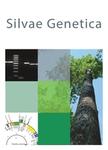版权所有:内蒙古大学图书馆 技术提供:维普资讯• 智图
内蒙古自治区呼和浩特市赛罕区大学西街235号 邮编: 010021

作者机构:Forest Seed Res Ctr Korea Forest Res Inst Chungju 380941 Chungbuk South Korea Korea Forest Res Inst Tree Breeding Div Suwon 441847 Kyonggi South Korea
出 版 物:《SILVAE GENETICA》 (Silvae Genet.)
年 卷 期:2008年第57卷第3期
页 面:131-139页
核心收录:
学科分类:0710[理学-生物学] 0907[农学-林学] 08[工学] 0829[工学-林业工程] 09[农学]
主 题:linear regression model AMMI model provenance test
摘 要:Thirty-six provenances of Pinus densiflora were evaluated for stability and adaptability for height growth at 11 test sites in Korea. The data were obtained from measurements at age 6 and analyzed using linear regression model and AMMI (additive main effect and multiplicative interaction) model. There was significant provenance by site interaction effect (p 0.011). The interaction term explained 7.1% of total variation. While the regression model accounted for 15.8% of GxE interaction term, the AMMI model accounted for 74.9% with four PCA values. Most of the provenances were not significantly different from the unity (b = 1.0), except for Inje (1), Jungsun (4), Bongwha (5), Koryung (26), Hamyang (30) and Seoguipo (36). Adaptability of provenances to the test sites was estimated with mean height growth and first AMMI component scores (IPCA 1). Inje (1), Bongwha (5), Taean (20) and Seoguipo (36) were specifically adapted to the high yielding environments. Considering the first and second AMMI components (IPCA 1 and IPCA 2, respectively) scores, Whachun (2), Samchuk (10), Joongwon (14) and Buan (29) provenances were more stable than others. The implication of GxE interaction was discussed in view of seed transfer and delineation of seed zones.